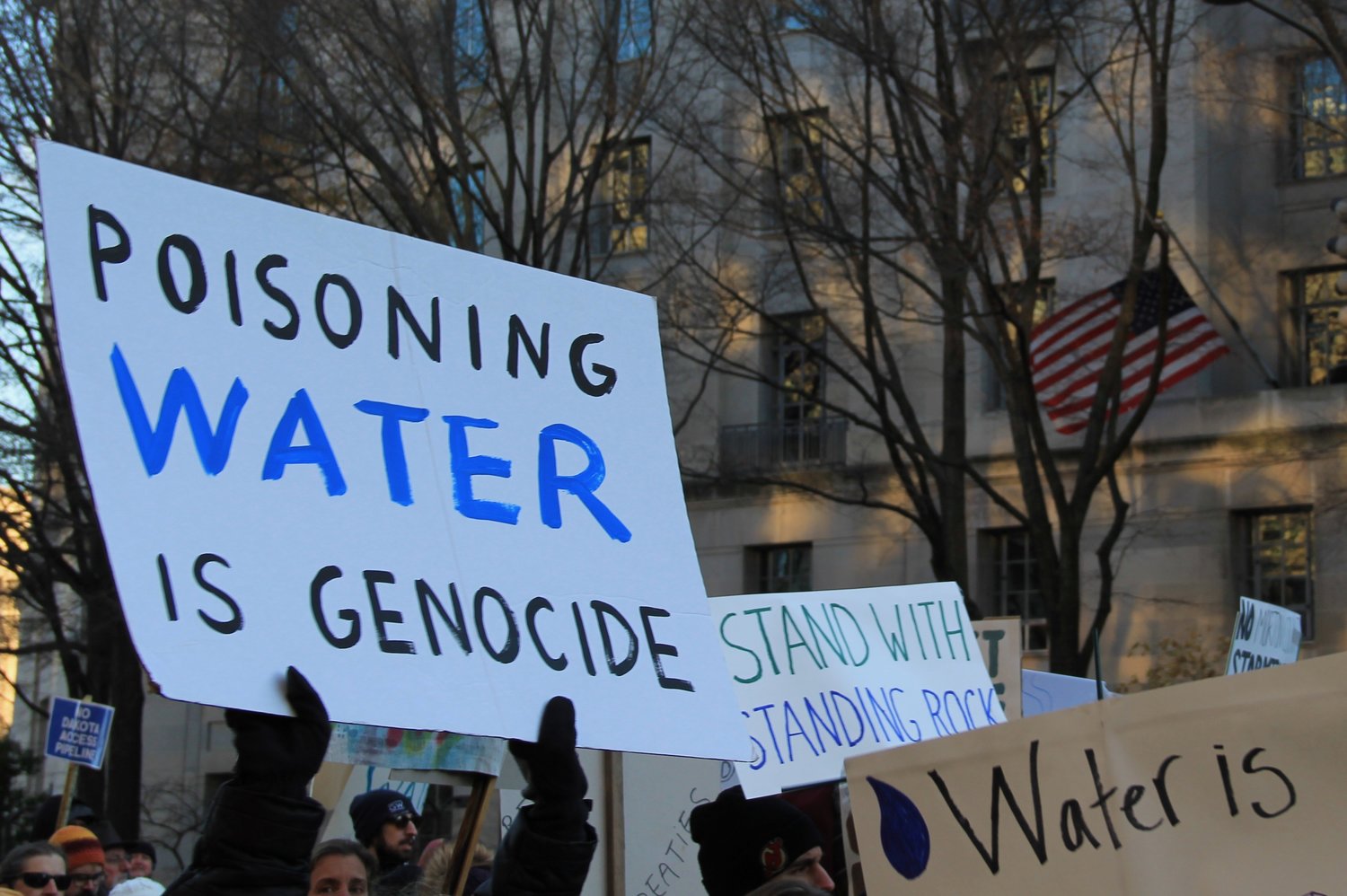Canada has one of the largest supplies of renewable fresh water in the world. So why do we have such a troubled relationship with a resource that should be available to everyone?
BY NICHOLAS MIZERA
Canada’s attitude toward water is marked by a great, perhaps disturbing, irony: despite evidence that the supply of this life-giving resource faces mounting danger, we tend to see its management and conservation as somebody else’s problem. We assume government regulators have it handled and we blindly trust billion-dollar corporate interests to do the right thing. We take for granted that water, seemingly so abundant in our country, will keep on flowing.
This troubling attitude toward the commodification of our most important resource, marked by a mix of advocacy and reluctance, could prove disastrous: what many Canadians seem to be missing is that there are billion-dollar industries turning out staggering profits as our most precious resource is pumped out from underneath us.
RELUCTANCE
According to the 2017 RBC Canadian Water Attitudes Study, “For the 10th year in a row, Canadians named water our most valuable natural resource. Yet we remain world-class water wasters and report taking fewer actions to conserve water last year than we did in 2008.” Most respondents agreed that Canada should take responsibility for managing its water better, and 77 percent of respondents were convinced that Canada will face a fresh water shortage in the future without good conservation habits. But many were still unwilling to personally absorb the costs of conservation measures. Instead, nearly half of Canadians “strongly agreed” that enterprises should pay the full costs of delivering and treating the water they use, and a similar percentage want the government to play a stronger role in improving the resource’s outlook.
At the root of this problematic attitude could be, in part, the business of water’s deep complexity. The number of players, both public and private, vying for access to the resource are plenty, creating an echo chamber of voices (and offering plenty of targets ripe for finger wagging). Canada is also steward to one-fifth of the world’s fresh water, lending to the nation’s outsized role in global water conservation an even more dizzying scope. For all its facets, however, one thing is clear: as the conversation over water and its future evolves, it is increasingly characterized by a widening divide between North America’s haves and have-nots.
PUBLIC RESOURCE VS. PRIVATE PROFIT
Beneath the surface, there’s long been a tension boiling between those who need clean, accessible water to live and the companies often portrayed as tapping it for profit.
The origins of Canada’s formalized beverage industry can be traced back to the early 1900s. Canada’s fledgling bottled water companies had sprung up in the decades around the First World War — not much more than a few companies around Toronto and Montreal. In 1942, Canadian Bottlers of Carbonated Beverages — now the Canadian Beverage Association — formed a coalition of more than 500 independent bottlers to support the industry’s interests. After the Second World War when the rationing of sugar, glass and gasoline ended, the beverage sector steadily grew into the 60,000-job industry it is today.
Bottled water in particular captured the modern public’s imagination in the mid-aughts, becoming a flashpoint for those concerned about the privatization of an essentially public resource. According to Agriculture and Agri-food Canada, the bottled water industry experienced sustained growth in the early 2000s as consumers looked for healthy alternatives to sugary drinks. Later that decade, increased scrutiny and environmental concerns dampened some of the industry’s momentum, but that didn’t stop Canadian bottled water from eventually swelling into an industry with an estimated $2.5 billion in annual sales by 2017.
Industry critics and environmental groups have mainstreamed the image of multinational corporations pumping public water — and selling it back to consumers at a markup. Nestlé Canada, the brand behind Pure Life, Poland Springs and Perrier, became one such bugaboo when it — unknowingly, according to reports — outbid the small, drought-stricken Township of Centre Wellington in Ontario for access to a Middlebrook drinking water supply site in 2016. The company had already controlled a bottling plant in nearby Aberfoyle, where at the time it pumped 3.6 million litres of water per day. The Aberfoyle plant itself was the centre of controversy when a Guelph-based groundwater watchdog, the Wellington Water Watchers, accused Nestlé of pumping water even after its water-taking permit had expired.
Topping off a list of perceived injustices was the fact that, at the time, Nestlé and other Ontario water-bottlers were being charged a provincial rate of $3.71 per million litres of water, according to a report by The Canadian Press. According to The Toronto Star, bottled beverage companies Pepsi Co. and Coca-Cola fill up directly from municipal taps for a similarly small fee, “a fraction of what household residents pay.” After public outcry over the report, the Province of Ontario proposed in January 2017 to increase water-taking fees for water-bottling companies to $503.71 per million litres — but that misses the point.
“We don’t believe that these permits should exist in the first place,” says Mike Nagy, the chair of the Wellington Water Watchers, the group that squared off against Nestlé in the abovementioned dispute. “No amount of money is going to create more water.”
Nagy argues that when Ontario began to issue water-taking permits almost three decades ago, the province couldn’t have imagined multinational corporations muscling in on the public commons to the degree that they have.
That’s not to say corporations see themselves as the bad guys. Many companies, including Nestlé, do make commitments to the resource’s sustainability and play up corporate social responsibility at the heart of their proposition. FLOW Water, for example, fashions itself an industry disruptor after they opened a new manufacturing facility in Aurora, Ontario, north of Toronto, in May 2017 with an eco-first model that minimizes waste through green bottling facilities, uses easily recycled TetraPak boxes instead of bottles, and taps sources as close as possible to target markets to ensure a minimal carbon footprint. “North American consumers have proven the demand for products and brands that put eco-innovation at the forefront,” said Carmen Becker, President and CEO, Tetra Pak U.S. and Canada, in a statement from the plant’s opening.
But as well-meaning as Nestlé and other water profiteers (as Nagy calls them) may seem, there will never be a balance between corporate interests and the public’s. Their goal will always be to acquire and sell more water; and if profit isn’t their central tenet, they’re still tapping what’s ultimately a public resource for profit, he says.
It’s remarks like Becker’s that suggest that it’s the consumer who will determine the future of this industry — and as long as consumers take access to water and the power of their purchases for granted, she’s not wrong.
People have short memories, remarks Nagy, and changemakers may live in cities like Toronto that are insulated from the realities of water’s scarcity. Canadians already thought cod and forests were limitless, only to be proven wrong — it’s only a matter of time before everyone feels the squeeze as water supplies dwindle.
“We have to get past the illusion of water’s endless abundance,” says Nagy. “We’re already running out of water in much of Canada because water scarcity is a thing of the present and the future.”
LOW ACCESS, HIGH STAKES
The numbers back Nagy’s claim. A 2009 Environment and Climate Change Canada report found that “human pressure on the water supply is not necessarily applied in areas where water is abundant.”
In fact, the biggest guzzlers of freshwater are mostly urban centres within 300 miles of the U.S. border in Southern Ontario, Alberta, and Manitoba. There, the report states, water supply is under the greatest threat of becoming scarce, owing to urban, agricultural, and industrial growth. These regions have withdrawn more than 40 percent of lakes and groundwater for human use — of which less than half is considered a renewable resource — while 60 percent of freshwater flows northward into the Arctic Ocean. And yet, one would be challenged to find alarm bells ringing at the policy level in these densely populated places.
If Canada’s track record of addressing First Nations water access issues — one of our nation’s longest-running emergencies, and rightly a source of national shame — is any indication, it may take some time for Canadians to take the signs of increasing scarcity and diminishing access seriously.
Canada only recently began taking sweeping measures in response to the lack of accessible water facing its First Nations — strengthening on-reserve water and wastewater infrastructure, and training First Nations to support them. In a speech delivered to the Assembly of First Nations Special Chiefs Assembly, Canadian Prime Minister Justin Trudeau pledged to end all drinking advisories in First Nations communities by 2021. “It means that if you are a child living on reserve, you should be able to turn on the tap and have clean water come out. Water that you can drink, and bathe in, without fear,” he said.
Tell that to the some 150 communities dealing with such advisories listed on the federal government’s website. A boil-water advisory for the roughly 250-person First Nation of Neskantaga dates back to 1995. And the odds are increasingly being stacked against Indigenous peoples’ favour as their lands are industrialized by energy producers and agricultural interests.
Water consumption from fracking, a means of extracting underground oil and natural gas, has become one such concern, particularly in parts of British Columbia. Ben Parfitt, the author of a June 2017 report by the Canadian Centre for Policy Alternatives that found that hydraulic fracking violates First Nations rights, writes that “Natural gas drilling and fracking operations have devastated [northeast B.C.] First Nations, steadily eroding their ability to hunt, fish, trap and carry out other traditional practices, which are supposed to be protected by Treaty 8,” a numbered treaty that governs a region a little smaller than Venezuela in northern Alberta, British Columbia, and Saskatchewan. Parfitt also points out that fossil-fuel companies built unauthorized dams and contaminated watersheds that are relied upon by communities such as the Blueberry River First Nations. An explosive 2016 report, Atlas of Cumulative Land Disturbance in the Traditional Territory of Blueberry River First Nations, claims that approximately 84 percent of Blueberry River territory is within 500 metres of an industrial disturbance.
That’s just one dramatic example. First Nations are dealing with the deadly effects of industrialization and water mismanagement across the country. Earlier this year, Ontario earmarked $85 million to clean up the Wabigoon River, which had been contaminated with 10 tonnes of mercury between 1962 and 1970 by a paper plant in Dryden about 100 kilometres upstream of the Grassy Narrows peoples and Wabaseemoong Independent Nations. The bottom of Nova Scotia’s Boat Harbour, nearby the Pictou Landing First Nation, is so contaminated by 50 years of toxic pulp effluent that it has become elastic.
THE BUSINESS OF WATER
These challenges at home, and similar ones abroad, have given rise to an entire industry devoted to meeting the burgeoning demand for sustainable water solutions, whether that means treating wastewater so it can be reused, increasing the efficiency of water-intensive manufacturing processes, and reducing environmental impacts.
Canada is fast becoming a world leader in such water technologies, with new companies born almost weekly. Between industrial, university-based, and private-sector research — primarily in wastewater and drinking water — Ontario alone spends about $14 billion on such research, making it a world leader. On a federal level, the Liberals’ 2017 Budget makes room for innovation for green investments, including $950 over five years to support business-led innovation “superclusters,” like those forming around water technology in British Columbia, and $43.8 million over five years to protect 17 percent of land and inland waters, and 10 percent of coastal and marine water. The lofty goal? “Clean drinking water for every Canadian, no matter where they live.”
But spurring innovation is a difficult proposition no matter the industry, and encouraging business-led innovation may be even tougher. For one, if an industry already meets water-use or purity standards set out by regulators, there’s less impetus to seek innovation, says Kevin Bossy, CEO of environmental solutions company Bishop Water Technologies at Toronto’s MaRS Discovery District.
“There is a real reluctance — and reluctance doesn’t do it justice — to embrace innovation within something that is so key to health,” says Bossy. “It could be — and can be, as in the case of Flint, [Michigan] — catastrophic.”
Finding a solution can be more appealing when all players accept responsibility, ensuring no single industry, advocacy group or government is saddled with the burden of fixing Canada’s 3,500-billion-cubic-metre water question, says Bossy. “We can say this is a shared issue and we can, by collaborating together, create sustainable solutions to our problems.”
As someone who’s devoted his efforts to help champion water technology entrepreneurs as a member of the board at WaterTap Ontario, the province’s water technology champion, Bossy feels there is still a bright future for innovation.
Jonathan Rhone, CEO of industrial wastewater solutions company Axine Water, agrees — in fact, he considers so-called “clean tech” the fastest-growing market in the world. To keep the momentum going, he points to the importance of communicating that environmental technologies aren’t just saving the world — they’re extremely profitable. He’s heard plenty of political rhetoric to the contrary, particularly in the United States where going green is often pitted against economic stability.
“I think that most of us in our sector believe that that is rubbish,” he says. “In fact, we think a strong environmental ethos — which is really all about efficiency — is actually an imperative for productivity.”
Demystifying clean technologies, highlighting profits and increased productivity, and promoting a collaborative approach to solutions facing all Canadians are all keys to ensuring a viable future for water in Canada and beyond, Rhone suggests.
“Because if we expect corporations to behave on a moral basis, we’ll be waiting a long time.”








